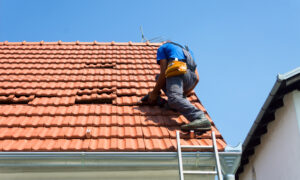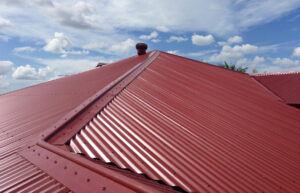An industrial roof can be constructed from a wide variety of materials. These can include felt overlays, built-up roofing, or single-ply membranes. These systems require regular maintenance to avoid leaks and other problems.

An excellent commercial roof is essential to a business. A faulty roof can allow pests and moisture to enter the building, contaminating equipment and increasing operational costs. A roof that is in poor condition can also cause energy inefficiencies. Visit https://redstickroofing.com/baton-rouge for more information.
Roofers specialize in the installation, repair, and replacement of roofs for commercial and residential buildings. They use a variety of materials, including wood, shingles, tiles, steel, and other metals to create and maintain sturdy, durable, and weatherproof building structures. They also inspect existing roofs to determine the best procedure for repairing them. Those who choose to become roofers are required to have a high level of physical stamina and a strong understanding of construction safety protocols.
Depending on the type of roofer, work environments may differ. Those who are employed by roofing companies typically have a more structured work environment, while self-employed roofers have more flexibility in their schedules. In addition, the amount of time spent on a job will vary depending on the weather conditions. Roofers must be comfortable working in hot and humid conditions and have the physical strength to lift heavy equipment.
Most roofers receive on-the-job training before they can begin work on a site. During this period, experienced roofers will teach new workers how to use the tools and equipment of the trade. Typical on-the-job tasks include setting up scaffolding, hoists, and other roofing equipment. Workers will also learn to measure and cut materials for a specific project. Once they have mastered these skills, a roofer can begin to work on their own.
As a result of the recent hurricanes, the demand for roofers has increased. This has caused a shortage of roofing materials, and prices have increased as well. This is expected to continue until supplies of roofing materials replenish themselves. Those who are considering becoming roofers should carefully consider the availability of these materials and their cost before making a final decision.
Roofers usually work full time and may have to do overtime during periods of rain. However, this is a good career choice for those who are looking for a career that provides stability and security. Those who enjoy working with their hands and are skilled with hand tools may find this to be an ideal career option. This trade is less vulnerable to downturns than other types of construction jobs.
Job Flexibility
Roofers are often required to work in a variety of different environments. Typically, they work on construction sites alongside other professionals such as carpenters and electricians, which requires flexibility in scheduling and project coordination. Industrial facilities, such as factories or manufacturing plants, may have specialized roofing needs due to their unique environments. This may require a more collaborative approach to project management and additional safety protocols.
Many people enjoy the job flexibility offered by an industrial roofer. The career is not a stagnant one, and there are always new opportunities for those with the right skills and attitude. People can move up the ladder to become a roofing supervisor, for example, and take on more managerial roles and responsibilities. This can be a great way to earn a higher salary, while still enjoying the flexibility of working on your own schedule and being your own boss.
Unlike some other careers, being a roofer does not require formal training. Rather, people can learn the necessary skills through on-the-job training or through college courses and apprenticeships. In addition, they can also use their experience to open their own roofing business or become a contractor.
One of the main challenges that industrial roofers face is finding enough qualified workers. While there are a number of reasons for this shortage, some of the most important include misperceptions about potential earnings and stereotypes about trade jobs. In order to combat these problems, businesses should be proactive in recruiting and retaining employees. Some ways to do this include offering flexible hours, paid time off, and other benefits like free food.
Additionally, companies should consider implementing customer service strategies that promote employee retention and satisfaction. For example, they should be sure to respond to phone calls quickly and answer any questions or concerns that customers have. This will help to ensure that customers have a positive experience with the company and are satisfied with their roofing services.
Finally, businesses should offer incentives to keep their roofers happy and productive. This can be as simple as saying “thank you” more frequently or publicly complimenting outstanding work and efficiency. They can also encourage employees to stay hydrated and healthy by providing water, snacks and meals before, during and after work. Even the most motivated and skilled workers will lose their efficiency if they are tired or hungry.
Job Security
A leaking industrial roof can have serious implications for a business, from water damage to stock and equipment, to reduced energy efficiency, increased operational costs and even health and safety risks for employees. This makes having a professional roofing contractor on hand to inspect and repair any damage to the roof or skylights crucial. Industrial roofers work on all kinds of commercial buildings, from warehouses to offices and retail outlets. Their responsibilities may include installing new roofs or replacing existing ones as well as conducting regular inspections.
To ensure the safety of workers, industrial roofers must be able to follow strict regulations for working at heights. They also need to be able to read and interpret blueprints and construction plans. In addition to these skills, roofers need to have a strong desire to learn and improve their craft as well as excellent customer service skills.
The specialized skills required for roofing mean that industrial roofers are in high demand, especially as other tradespeople leave the field for better pay and benefits. This means that it can be difficult to find a job as a roofer, but if you are able to secure a position, the salary can be rewarding. The average salary for a roofer is around $40,000, with a foreman making a bit more and project managers or roofing estimators earning well into the six figures.
While there are some advantages to becoming a skilled trade worker, it is important to understand that you will face competition from other tradesmen who have the same credentials and skills. This is why networking is so important for those in the trades, as it allows professionals to connect and share knowledge, resources and job opportunities.
One of the best ways to network as a tradesman is to join industry associations. This will give you access to events and meetings that allow you to meet other tradesmen and stay up-to-date with the latest trends and developments in the industry.
The booming economy is creating an increasing need for skilled trade workers, and roofing jobs are no exception. This is a great time to consider a career as an industrial roofer, with the BLS projecting 11% growth for this sector through 2026.
Earning Potential
The roofing industry offers a stable job with a high salary. It also offers plenty of opportunities to advance within the profession. There are a lot of positions available and the industry is in need of adept professionals.
Roofers get the opportunity to work on a wide variety of different projects and buildings. They can find jobs in residential areas, commercial buildings, construction sites, and even industrial facilities.
These professionals can also choose to focus on certain types of roofing projects, depending on their preferences and the demands of the market. For example, roofers who specialize in a particular type of roofing system can offer more competitive rates and may have greater opportunities for employment.
Moreover, roofing is a growing industry and is in constant need of workers. The demand for roofing professionals is driven by the need to repair aging structures, the need to build new homes and businesses, and by the impact of weather on buildings. This is a great industry to enter if you are looking for a steady income and long-term security.
A career in roofing is a great option for people who enjoy a hands-on job with lots of physical activity. It can be rewarding and fun, and it can help you stay in shape and feel accomplished at the end of a day’s work. If you’re interested in a physically demanding and rewarding career, consider becoming an industrial roofer.
In addition to being able to use various tools and equipment, you must be comfortable working at heights. You should be able to read blueprints and construction plans and understand safety standards and regulations. In addition, you must have good analytical problem-solving skills and be able to identify issues quickly. You must also have a valid driver’s license and reliable transportation.
The average annual wage of an industrial roofer is around $42,363. The average hourly wage is $20. These salaries vary by location and company. In some cases, an individual’s salary will be based on their education, certifications, and experience.











